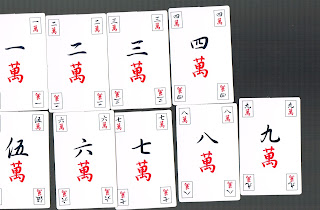Daiini ( 大二) , Nintendo, 40c. + Oni-fuda + blank
Again, we have another Kabu deck, Daiini- "Big Two" . The structure of this dck is not very different from the other decks of it's family, but several features make it worthy of mention:
1- The court card and ace have now been further abstracted, to such a point that they now are a few unrecognisable blobs of colour, only ( vaguely) retaining their original shape . It appears that I have displayed the knave ( 1st image, 1st row, 5th from left) upside down, but the design is so abstract, IMO, it makes little difference!
2- The 4s have a little circle in the middle of their 4 pips; It contains the characters "大二" - Daiini- thus spelling out the pattern's name. The deuces ( 2s) reflect this, as their pips are rather large when compared with the others
( top row) - 6, 7 , 8, 9, ( Knave)
( bottom row) ( ace) , 2, 3, 4, 5
L-R - Onifuda, special ace, special 3, special 4
The "special" ace, 3, and 4. are not very far removed from other such decks , save the use of gold instead of silver ink. Note the Onifuda. The demon's eyes are framed in gold ink, thus giving it the rather comical appearence of wearing spectacles!
The knave displayed one way, and then another. I leave it to you to decide which card is " Right side Up" 





